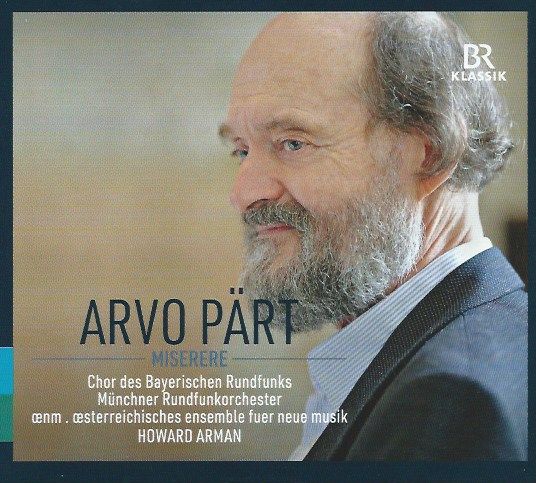Arvo Part: Miserere
A timely reminder of the importance of the Arvo Pärt's music

We met the Bavarian Radio Chorus and Howard Arman previously, in a lovely disc of Elgar, From the Bavarian Highlands and part-songs. Now it is the turn of Arvo Pärt, the great Estonian master. These discs are on BR-Klassik, the record label of the Bavarian Radio, the same label that brought us Mariss Janson's Bruckner Sixth Symphony recently. And here is a double celebration on that label: the 85th birthday of Arvo Pärt (September 2020) and the 75th anniversary of the Bavarian Radio Chorus (May 2021)
Arvo Pärt's works are imbued with a deep, radiant spirituality. Pärt is famous for his tintinnabuli style, which is heard here: a Minimalist-influenced application of various inversions of a chord that evokes the pealing of bells particularly in the overtones that such chiming brings with it ("tintinnabulum" is Latin for bell). On a technical level, Pärt often achieves this in a four-part texture by having two voices play the notes of a single tried, while the other two move in a step-motion. Early on in his output, Pärt used this in his now popular Cantus in Memory of Benjamin Britten (1977) for string orchestra and bell. See below for further details in relation to the Miserere.
This new disc (released March 12) includes both vocal and instrumental works written between 1986 and 2019.
While the booklet notes tell us much about the circumstances that gave rise to this disc, and thankfully provide texts and translations where appropriate, they don't actually tell us very much about the music; which is where we hope blogs such as Classical Explorer may come in useful!.
We start with Which was the Son of ... a 2000 piece for a cappella choir commissioned by the city of Reykjavík as part of their European Capital of Culture programme. It was performed then by a youth choir, and Pärt chose to set the text in English. The text is from Luke and traces Jesus' lineage back to Adam and the Christian Godhead (family names and lineage are an especially important part of Icelandic culture); the repetitive text imparts a meditative aspect, while Pärt's setting is itself gloriously varied, climaxing in multi-voice polyphony:
Taking its title from an oxymoron, Festina lente (Make Haste Slowly), a phrase famously used by Augustus, the first Emperor of the Roman Empire. The work is actually a modified canon (so the same melody is played, but at different speeds, which means you get faster versions of the melody played against slower versions: making haste slowly, one might say):
... what's lovely is how this piece bleeds into Tribute to Caesar (composed alongside The Woman with the Alabaster Box - not on this disc - to celebrate the 350th anniversary of the Karlstad Episcopacy in Sweden). Premiered in 1997, it takes a passage from the Gospel of Matthew where the Pharisses question Jesus about the tribute. Jesus' words are heard via the angular lines of the bass voices; the Pharisees are heard via full chorus.
Scored for percussion and string orchestra, Pärt's Sequentia (2005/19) is dedicated to Robert Wilson, Vadim Repin (there is a pronounced solo part for violin) and Andreas Mustonen. Its restraint (it often hovers on the borders of audibility) seems to cut to the heart of what Pärt is all about:
One of Pärt's most famous choral works is The Deer's Cry. Listen to this performance, how it holds the silences between the opening statements of "Christ, with me" for an example of just how compelling these performances are:
The collaboration between Arvo Pärt and the Bavarian Radio Chorus began in 1982 with the World premiere of Passio; while Pärt's characteristic sound is now familiar, in those days of the avant-garde (modern music concerts were dominated by Boulez, Stockhausen and the like), at that time Pärt offered a refreshingly new alternative.
The two instrumental works are Festina lente (1986/1900) for string orchestra and harp and Sequentia (2014/19) for violin, percussion and string orchestra, both performed by the Munich Radio Orchestra under Arman.
That Miserere, though, is simply astonishing. Listen to the remarkable instrumental writing in "Versus IV":
This is by far the longest piece on the disc. The 30-minute Miserere is for soloists, mixed chorus, ensemble and organ of 1989/1992. Here's a brief introduction to this recording:
The Bavarian Radio Chorus is joined by the œnm (the Austrian Ensemble for New Music; Österreichisches Ensemble für Neue Musik). This is a live performance of the Miserere from the 2019 Salzburg Festival.
The Miserere offers an excellent invitation to really dig into Pärt's tintinnabuli style, should the interested reader wish to pursue this. First, Versus XIII, "Ne proiicias me a facie tua" (Cast me not away from Thy presence: track 17 on the BR-Klassik disc):
..., and, if I may suggest if you follow the link to this article there is a fabulous illustration of Pärt's workings, including tintinnabuli, by David Clarke (no relation!):
David Clarke, and Arvo Pärt. "Parting Glances: David Clarke Reappraises the Music and the Aesthetics of Arvo Pärt." The Musical Times 134, no. 1810 (1993): 680-84. Accessed April 7, 2021. doi:10.2307/1002929 (you can register free with Google and you get 100 free articles; JSTOR is short for "Journals Storage").
Whether you read that or not, I would not want you to be without the radiant harmonies at the end of the work; or indeed the unleashed torrent of drama in the "Dies irae":
The disc ends with the consoling sounds of And I heard a voice ..., commissioned in celebration of the 800th anniversary of the University of Salamanca.
Also available on BR-Klassik are two other Arvo Pärt discs: 900319, which includes that Cantus in Memory of Benjamin Britten, and 900511, which includes the Te Deum. (links below).
